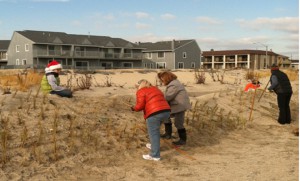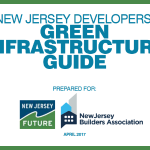New Jersey Future Blog
Getting to Resilience in Sea Bright
June 3rd, 2014 by Steve Nelson
The enormous impact of Superstorm Sandy is still being felt in dozens of communities across New Jersey, and with it a new understanding of the need to become more resilient to flooding hazards. Fortunately, a newly updated online tool is available and is being used to help communities take action to become less vulnerable and more prepared.
This tool – Getting to Resilience (GTR) – was developed by the New Jersey Department of Environmental Protection (NJDEP) and enhanced by staff from the Jacques Costeau National Estuarine Research Reserve (JCNERR). It allows communities to assess how prepared they are for flooding, coastal storms and sea-level rise. The GTR process includes assessing risk and vulnerability, engaging the public effectively, modifying land-use ordinances, steps to increase disaster preparedness and recovery, and implementing hazard mitigation strategies. Going through this process can be an eye-opener for communities as they learn the details of how prepared they are. The process can be completed either as a municipal self-assessment or using a facilitator. Actions taken as a result of the process can also help increase a town’s FEMA Community Rating System (CRS) score and thus reduce flood insurance costs.
Sea Bright has just completed its GTR exercise, facilitated by JCNERR staff and involving Borough staff, elected officials and New Jersey Future’s local recovery planning manager. Staff and elected officials scrutinized existing plans, ordinances, procedures, maps and historical data to determine how well prepared the borough is for flooding, coastal storms and sea-level rise. The results of this work revealed areas where the community has done a good job in preparedness and areas where there are opportunities to improve.
The process has produced a report full of recommended actions, and has also motivated elected officials to work on improving the borough’s resilience and preparedness. Recommendations include physical improvements, such as creating a continuous planted dune line; updating ordinances and plans; organizing and making information on flooding risks more available to borough elected officials, staff and the public in a variety of ways; incorporating sea-level rise projections into borough plans; and creating a mitigation plan for properties that are regularly damaged from flooding.
As a result of the GTR process and report, Sea Bright’s mayor has requested an action plan be created to guide implementation of these recommendations, and a public meeting will soon be scheduled to develop that plan. Once a formal application to FEMA is made, the report will also be used to increase the borough’s CRS rating.
For more information on the Getting to Resilience process and its benefits to a community for resiliency and lower flood insurance rates, please visit the JCNERR website.

















